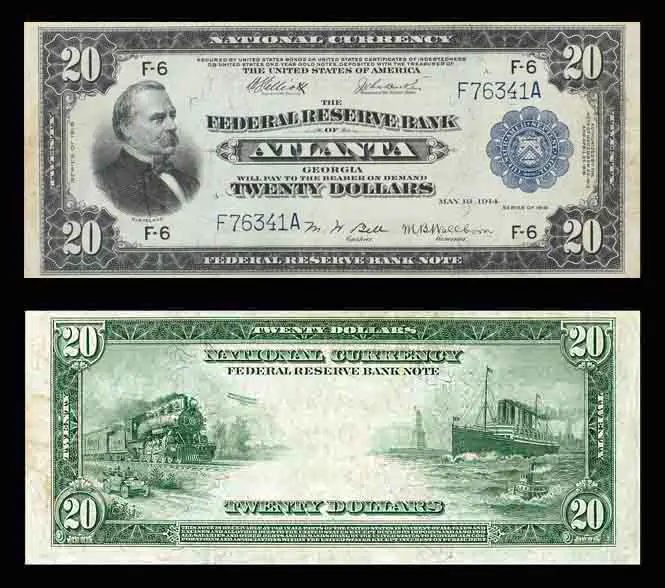- Home
- US $20 Bill
- 1918
How Much Is The 1918 20 Dollar Bill Worth?
The 1918 20 dollar bill is actually a Federal Reserve Bank Note.
They were issued under the Federal Reserve Act of December 23, 1913 as a type of emergency currency.
This 1918 $20 note is going to be worth more than face value in all grades that are legible.
A 1918 $20 bill is worth $1500 for a Very Good (8), $2800 for a Fine (12), $4500 for a Very Fine (20-35) and $17,500 for an Extra Fine (40-45).
The value of these notes is determined by the quality or grade, whether it has a fancy serial number, if it has a unique print error or if it's a star note.
What Does A 1918 Series $20 Note Look Like?

Image Courtesy of National Numismatic Collection at the Smithsonian Institution. (Unedited CC)
There are only two varieties of the 1918 $20 bill known to exist.
The F-823 from Atlanta which was signed by Elliot - Burke and Bell - Wellborn, and the F-825 from St. Louis which was signed by Teehee - Burke and Attebery - Wells.
The US Twenty Dollar note shown above is a F-823 from Atlanta.
They were only issued by the banks of Atlanta and St. Louis and are very valuable in any condition.
You could expect to get around $1600 for something as low as a grade VG-8 because these FRBN's are so rare.
The obligation as the top of the face side has been changed. It now reads:
"SECURED BY UNITED STATES BONDS OR UNITED STATES CERTIFICATES OF INDEBTEDNESS OR UNITED STATES ONE-YEAR GOLD NOTES, DEPOSITED WITH THE TREASURER OF THE UNITED STATES OF AMERICA."
On the far right of the 1918 series it reads, "AUTHORIZED BY THE ACTS OF DECEMBER 23, 1913, AND APRIL 23, 1918."
1918 20 Dollar Bill Serial Number Lookup
- Series: 1918
- Denomination: $20 USD
- Seal Varieties: (1) Blue
- Signature Varieties: (2) Elliot - Burke, Teehee - Burke
- Bank Varieties: (2) Atlanta (F), St. Louis (H)
The 1918 series Twenty Dollar Bill was only issued by two banks, Atlanta and St. Louis.
Notes from St. Louis are worth more because they are rare and there aren't any star notes known from that year.
So, if you look at the serial number on your $20 Federal Reserve Bank Note, you will notice that it starts with either a F or H.
F means it was issued by the bank of Atlanta and H means it was issued by the bank of St. Louis.
This letter should correspond with the name of the bank printed in the center of the note. If it is a different bank, then it's fake.
It will then have 5 numbers and another letter at the end. The letter at the end just refers to which block it was printed in.
Fancy Serial Numbers
Fancy or special serial numbers such as radars, ladders, repeaters or even birth dates, can make a note much more valuable.
Some examples of fancy serial numbers for the 1918 Atlanta bank note would be F12345A (ascending ladder), F00001A (first bill printed) and F66666A (solid).
The St. Louis note might look like H69169A for a rotator and H54321A for a descending ladder.
Birth dates are usually only found with eight digit serial numbers. For example F09231976C.
Return from 1918 20 Dollar Bill to the Lost Treasure HQ Homepage.


